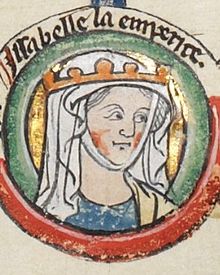Isabella of England
| Isabella of England | |
|---|---|
 |
|
|
Holy Roman Empress; Queen consort of Sicily |
|
| Tenure | 15 July 1235 – 1 December 1241 |
| German Queen | |
| Tenure | 15 July 1235 – May 1237 |
| Born | 1214 Gloucester, England |
| Died | 1 December 1241 (aged 26–27) Foggia, Apulia, Italy |
| Burial | Andria Cathedral, Italy |
| Spouse | Frederick II, Holy Roman Emperor |
| Issue | Margaret, Landgravine of Thuringia |
| House | Plantagenet |
| Father | King John of England |
| Mother | Isabella of Angoulême |
Isabella of England (1214 – 1 December 1241), was Holy Roman Empress, Queen of the Germans, and Queen consort of Sicily.
She was the fourth child and second daughter of King John of England and Isabella of Angoulême.
At a friendly meeting at Rieti, Pope Gregory IX suggested to Emperor Frederick II that he marry princess Isabella, a sister of Henry III of England. At first Frederick II was concerned to lose his French allies; but when he realised that an English marriage might end the ongoing Anglo-French feud and constitute an important step towards the restoration of peace in Western Christendom, thus smoothing the way for a successful crusade, he agreed. The betrothal was formalized in London in February 1235.
Her brother Henry had to levy an unpopular tax of two marks of silver per hide in order to afford the thirty thousand marks Frederick insisted on as Isabella's dowry. Frederick sought this large amount to help fund his wars in northern Italy.
The beautiful Isabella was about twenty-one years old when she set out to marry the twice-widowed Emperor Frederick II, who was forty. On her way through Cologne, she delighted the local women when she removed the traditionally worn veil so that they could see her face.
The marriage between Isabella and Frederick took place in Worms Cathedral on 15 or 20 July 1235; in the ceremony, she was also crowned Holy Roman Empress, Queen of Germany and Sicily. She was granted the castle of Monte Sant'Angelo by her husband upon her marriage.
However, as soon as she was married she was added to the Emperor's harem, which included women from Arabia attended by black eunuchs. Their marriage had been a political match, and she was allowed to keep only two of her English women-attendants, Margaret Biset, who probably had been her nurse, and her maid Kathrein; the others were sent home.
Isabella lived in retirement at Noventa Padovana where her husband regularly visited her. When her brother, Richard, Earl of Cornwall, returned from the crusades, he was allowed to visit her, although Isabella was not allowed to be present at the official reception. While the imperial court resided at Foggia, Isabella gave birth to her last child and died. She is buried beside Frederick's previous wife, Queen Isabella II of Jerusalem, in Andria Cathedral, near Bari.
...
Wikipedia
